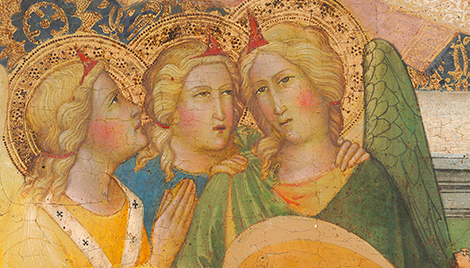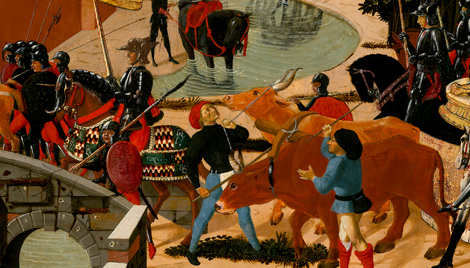Infant Savior with Saints and Donors (Triptych)
Infant Savior with Saints and Donors (Triptych)
- Artist
- Anonymous French or Flemish
- Artist Nationality
- French; Flemish
- Title
- Infant Savior with Saints and Donors (Triptych)
- Date
- c. 1480
- Medium
- tempera on panel
- Dimensions
- 76.8 cm x 127.6 cm x 6.03 cm (30-1/4 in x 50-1/4 in x 2-3/8 in)
- K Number
- K1071
- Repository
- Montgomery Museum of Fine Arts
- Accession Number
- 1936.0008
- Notes
Provenance
(F. Kleinberger); (his sale, American Art Association- Anderson Galleries, New York, 18 November 1932, no. 39); Samuel H. Kress [1863-1955]; gift to the Montgomery Museum of Fine Arts, Montgomery, Alabama in 1936, no. 1936.8; on loan to the Birmingham Museum of Art.
Catalogue Entry
Anonymous French or Flemish
Infant Savior with Saints and Donors (Triptych)
K1071
Montgomery, Alabama, Montgomery Museum of Fine Arts (P362), since 1937. Oil on oak. B: 23 3/4 x 20 1/4 in. (60.3 x 51.4 cm.), cut down at top. A: 22 x 8 in. (55.9 x 20.3 cm.). C: 21 5/8 x 8 1/4 in. (54.9 x 21.0 cm.). A: Painted within a red circle are the golden letters IHS (for Jesus Hominum Salvator) and In nomine Jhesu Omne Genu flectatur celestium, terrestrium et infernorum (Philippians 2:10-11, 'That at the name of Jesus every knee should bow, of things in heaven, and things in earth, and things under the earth').(1) Central panel: in the upper left corner the arms are: or on a chevron gules between three parrots vert, five fleurs-de-lis argent, below a knight's helmet crowned and the motto J'ay bien; they belong to Jean Wouters le Jeune (shown as a child in K1071A), the son of Jean Wouters (kneeling in K1071A) and Jossine de Beste (kneeling in K1071C). On 24 August 1505, Jean le Jeune married Marie de Nieuwenhuyse. The daughter of Josse and Jossine van Laenen, Marie died in 1532, leaving four children. The love-knot at the top of K1071 joins the initials of Jean (I) and Marie (M).(2) (The family motto J'ai espoir is not included on the Kress triptych.) At the upper right, the Wouters arms are shown with those of the Van Nieuwenhuyse: azure a house fenestrated or, surrounded by an interlace with the device A bien viengne. The letters IM at the top center are joined by love-knots. Left panel: the arms supported by an angel: or on a chevron gules between three parrots vert, five fleurs-de-lis argent, below a knight's helmet crowned. A mantling showing a jousting helmet with a dragon above has the motto: Plus est en Dieu. The arms are repeated on the prie-dieu: they belong to Jean Wouters (shown kneeling in this panel), who was President de la Chambre des Comptes at Lille (1513), first in the Chambre's employ in 1477. He was in the service of Philippe le Beau. Wouters died on 18 August 1519, and was buried in the Parish Church of St. Martin de Ackerghem (Ghent).(3) Right panel: the arms held by the angel: Wouters, as above, dexter: sinister, argent across gules, in the first quarter a parrot vert. The latter arms, those of Jossine de Beste, are repeated on the prie-dieu below. The motto at the top: Ma fiance est telle. Jossine de Beste (shown kneeling at the prie-dieu in this wing) married Jean Wouters at an unknown date. They had two children, Jean and Elisabeth, shown in K1071A and C. Jossine died 4 April 1505. Panels cradled and restored in 1933 by Pichetto. Upper central section of center panel abraded; the Christ Child severely damaged and the donor heavily restored. Central panel (and probably the wings) split at an unknown date to separate the painting on the front from that on the back; the present central subject was originally on the back of the panel; the painting on the front is lost.(4) Ten angels venerate the central roundel inscribed with the initials of Christ placed against a dark, bluish-green ground. The nude Holy Infant is above, turned slightly to the left, seated upon a tasseled cushion, his right hand raised in benediction, the other holding a red cross.(5) Golden rays, extending behind the central medallion, emanate from a nimbus behind Christ. With the exception of the left central angel and one at the lower right, all others have their hands joined in prayer. The angels are clad in pastel colored, alb-like liturgical garments with long, gold tasseled cinctures going over each angel's shoulder and tied around the waist. A donor facing right, his hands folded in prayer, kneels at a prie-dieu with an open book. He wears red and green fur-lined robes; his little son in white fur-trimmed robes kneels to the left. A bearded St. John Baptist in a hair shirt and flowing red mantle over the right shoulder stands to the left. He holds a lamb (with golden cross and banner staff) on a book with his left hand; the saint's right hand is placed close to the kneeling donor's shoulder. Golden rays shine from his head. All three figures are seen against a low wall with an arch-like relief. A flying angel in pink holds the Wouters' arms at the top, framed by a golden lattice. A landscape vista with several buildings is seen in the background. Jossine de Beste (Wouters) kneels before a prie-dieu at the right with an open illuminated book showing the Virgin and Child.(6) She wears a white coif, a black and white dress with a robe doublee; the knotted girdle, probably of the female Franciscan Ordre de la Cordelière founded by Anne de Dretagne, is around her waist. Her little daughter, Elisabeth Wouters, kneels to the right in black attire also with a Cordelière. Jossine's patron St. Jodocus, haloed, stands behind her, facing left.(7) He grasps a pilgrim staff with his left hand, a crown over his wrist. A pilgrim's hat with three gilded shells is on his back and a crimson cloak over his shoulder. The background is similar to that of K1071B. At the top an angel in yellow displays the donatrix' coat of arms and motto. The cult of the Holy Name of Jesus was especially revered by the Franciscans.(8) Both the donatrix and her daughter seem to have belonged to a Franciscan sodality. Friedlander described the triptych as a French work of c. 1480.(9) According to Burroughs, K1071 dates from the early sixteenth century and was painted by an artist of the school of Memling, active in France. He related the triptych to the style of a triptych of the Life of St. Anne in the Jolmson Collection (Philadelphia Museum of Art) which was mistakenly attributed to Jean Bourdichon. On the basis of the style of the coats of arms, he dated the triptych c. 1500.(10) As first noted by Frankfurter, the triptych's present central subject was originally placed on the back rather than the front of the panel.(11) At an unknown date the central panel was split in two. The wings were probably similarly treated. Another triptych, with the recto of the central panel and the verso of the wings, may be found. Possibly these areas may have been damaged, which could also account for their separation. The Holy Name of Jesus, a relatively rare subject for an independent composition in the North, is found on the verso of a Madonna and Child by the Master of the St. Ursula Legend (Cambridge, Mass., Fogg Art Museum). The original front of the central panel may also have shown a Virgin and Child enthroned, a popular subject for newly-wed couples' devotional triptychs. The flying angels to the left and right in K1071B/C may have reflected similar angels in the lost recto of the central panel. The latter may have shown a Virgin and Child with flying angels such as the ones seen in the Fogg panel).(12) In all likelihood the portraits of the children were added to the wings, which initially may have shown the then childless husband and wife shortly after their marriage. The exterior of the wings probably showed an Annunciation. Van den Bergen-Pantens placed the execution of the triptych c. 1490, as Jean de Wouters le Jeune, who married in 1505, looks extremely young.(13) She did not believe K1071 to belong to the French style, describing it as completely in accord with that of Bruges with a slight influence of Hugo van der Goes in the presentation of the donors and their patron saints.(14) As the Kress triptych was in all likelihood painted in Lille, officially French at the time, it could be included with French art, related in style to the oeuvre of Simon Marmion and Jean Bellegambe, both of whom were active in the same area. Their art, however, was founded on a Netherlandish basis. The master of the triptych was probably trained in Bruges in the 1470s. The abstract, elegant placement of the angels in the central panel recalls the art of the Maître des Moulins, another painter probably trained in the Netherlands but active in Burgundy. The date of 1490 for the execution of K1071 suggested by Van den Bergen-Pantens is plausible, but it may prove closer to Friedlander's proposed 1480, as the donor's children look as though they were added several years after the wings' completion. Provenance: New York, F. Kleinberger Gallery (sold, 18 Nov. 1932, New York, American Art Association, Anderson Galleries, Important Paintings by Masters of the Old Schools, p. 52, Cat. No. 39, as French, c. 1480). Kress acquisition 1932.
References
(1) The inscription is incorrectly transcribed by C. Van den Bergen-Pantens, 'Iconographie d'une alliance: les Wouters et les Beste', Le Parchemin, 16th ser., no. 140, Mar.-Apr. 1969, pp. 389-401, esp. p. 394. (2) See ibid., pp. 397-8, and M. de Veggiano, Nobiliaire des Pays-Bas, Ghent, 1865, II, p. 2153. The armorial and genealogical research for K1071 was initiated by Jessie McNab, who found major biographical data in the 'Généalogie de la famille Wouters', an eighteenth-century manuscript (Brussels, Bibliotheque Royale, Goethals Collection, no. G.M.1482, fols 1, 3, 4). Research has also been done by Van den Bergen-Pantens (art. cit., pp. 389-401), who included much new material concerning the donors' parents. (3) Ibid., pp. 396-7. For the biography of Jean Wouters, see M. de Veggiano, op. cit., p. 2152. (4) See technical report by Alan Burroughs, Kress Archive. (5) The Christ Child is mistakenly described by Van den Bergen-Pantens, art. cit., pp. 394-6, as holding an apple. The red of the cross symbolizes Christ's sacrifice. (6) According to Van den Bergen-Pantens (art. cit., p. 400), the miniatures belong to the School of Ghent-Bruges. (7) For a brief biography of St. Jodocus, see Frederick George Holweck, A Biographical Dictionary of the Saints, St. Louis, 1924, p. 532. St. Jodocus was also the patron of Jean le Jeune's parents-in-law, Josse and Jossine van Laenen. (8) For this device, see Hans Feldbusch, 'Christusmonogramm', Reallexikon zur deutschen Kunstgeschichte, Stuttgart, 1954, III, cols. 707-20. (9) Max J. Friedlander, certificate in Kress Archive, dated 4/II/32. (10) Kress Archive, c. 1933. The triptych is catalogued in Wilhelm R. Valentiner, German, French, Spanish, and English Paintings and Art Objects, Modern Paintings, Catalogue of a Collection of Paintings and Some Art Objects Belonging to J. G. Johnson, III, Philadelphia, 1914, pp. 24-5, Cat. No. 762, pls. 264, 265. (11) A[lfred] M. F[rankfurter], 'Eleven Gifts of the Kress Foundation', Art News, XXXV, 13 Feb. 1937, p. 5. (12) See C. T. Eisler, Les primitifs flamands, Corpus ... IV, New England Museums, Brussels, 1961, pp. 101-5, Cat. No. 76, pls. CXXII, CXXVIII. (13) Van den Bergen-Pantens, art. cit., p. 401. The donatrix' attire is related by Van den Bergen-Pantens (pp. 400-1) to similar clothing shown in paintings dated between 1478 and 1500. (14) Ibid., pp. 398-9.



